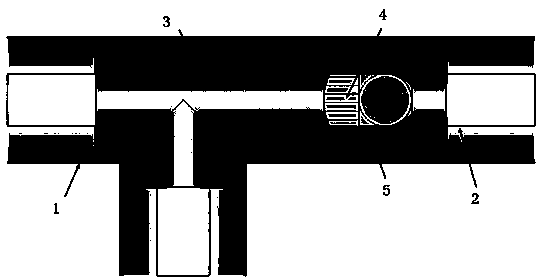A Large Dynamic Range Tunable Attenuator Based on Zero-Refraction Metamaterial
A large dynamic range, metamaterial technology, applied in waveguide-type devices, circuits, electrical components, etc., can solve the problems of low return loss, unsatisfactory accuracy, single mode, etc., to achieve increased return loss, large dynamic Adjustment range, the effect of improving performance
- Summary
- Abstract
- Description
- Claims
- Application Information
AI Technical Summary
Problems solved by technology
Method used
Image
Examples
Embodiment 1
[0023] In order to further illustrate the effect of the structure of this device, we take a coaxial line with an outer radius of 3.5mm and an inner radius of 1.5mm as an example to make an attenuator in which the rotating rod is connected to the inner conductor. Cut off a section of the selected inner conductor of the coaxial line, and process the truncated rotating rod and the connection with the inner conductor as follows: Figure 5 The required shape is fixed by mechanical means. Then at the T-shaped intersection of the coaxial line, the zero-refractive-index metamaterial is filled between the inner and outer conductors, such as figure 1 As shown, the filling range needs to cover the T-shaped intersection and the area of the rotating rod, but the rotating area of the rotating rod needs to be reserved as an air slot.
[0024] According to the novel attenuator proposed by the present invention and its manufacturing method, Example 1 is obtained by simulation design using...
Embodiment 2
[0026] In order to further illustrate the effect of the structure of this device, as a comparison, we take the attenuator with an angle of 45 degrees between the rotating rod and the inner conductor as an example. Except for the position of the rotating rod, other structures, dimensions and materials of the attenuator are exactly the same as those in Example 1. same. The corresponding attenuation value is -22.984dB, the return loss is -32.101dB, and the standing wave ratio is 1.05 according to the simulation test.
Embodiment 3
[0028] In order to further illustrate the effect of the structure of this device, as a comparison, we take the example of making an attenuator in which the rotating rod is connected to the outer conductor, that is, the angle between the rotating rod and the inner conductor is 90 degrees. Except for the position of the rotating rod, other structures and dimensions of the attenuator And the material is exactly the same as Example 1. The corresponding attenuation value is -72.253dB, the return loss is -53.084dB, and the standing wave ratio is 1.00 through the simulation test.
[0029] Through the above three examples, the present invention can be explained. When the attenuation value is in the range of -5.145~-22.984dB, the voltage standing wave ratio (VSWR) is less than 1.23; when the attenuation value is in the range of -22.984~-72.253dB, the voltage standing wave The ratio (VSWR) is less than 1.05.
PUM
 Login to View More
Login to View More Abstract
Description
Claims
Application Information
 Login to View More
Login to View More - R&D
- Intellectual Property
- Life Sciences
- Materials
- Tech Scout
- Unparalleled Data Quality
- Higher Quality Content
- 60% Fewer Hallucinations
Browse by: Latest US Patents, China's latest patents, Technical Efficacy Thesaurus, Application Domain, Technology Topic, Popular Technical Reports.
© 2025 PatSnap. All rights reserved.Legal|Privacy policy|Modern Slavery Act Transparency Statement|Sitemap|About US| Contact US: help@patsnap.com



